VYTAUTAS MAGNUS UNIVERSITY
Faculty of Economics and Management
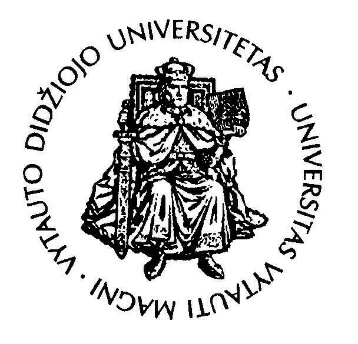
hOMEWORK / FAIRTRADE. LITHUANIA’S CASE
EKON3008_EN INTERNATIONAL TRADE
Student: x
KAUNAS, 2016
CONTENT
KAUNAS, 2016 2
CONTENT 2
INTRODUCTION 2
THEORETICAL ANALYSIS OF THE TOPIC 4
I.SHORTLY ABOUT FAIRTRADE 4
II.HISTORY OF THE FAIRTRADE 4
III.FAIRTRADE PURPOSES AND BENEFITS 6
IV.FAIRTRADE PREMIUM 9
V.POPULARITY OF THE FAIRTRADE 10
RESEARCH TOPIC ANALYSIS 10
I.SHORTLY ABOUT THE FAIRTRADE IN EUROPE 10
II.UK SUCCESS IN FAIRTRADE MARKET 12
III.FAIRTRADE PROBLEMBS IN LITHUANIA 13
IV.SITUATION IS GETTING BETTER 17
V.SPREAD THE BELIEF INTO THE FAIRTRADE 18
EMPIRICAL RESEARCH RESULTS AND VALUATION 19
CONCLUSIONS 21
REFERENCES 23
3.GlobeScan, Shopping Choices Can Make a Positive Difference to Farmers and Workers in Developing Countries: Global Poll 23
INTRODUCTION
Nowadays, when people are willing to share what they have with those who do not, Fairtrade becomes more and more important. This is a kindly way to spread the goodness, but everything is not so easy. Fairtrade includes a lot of things in one word, for example a social justice movement, an alternative business model, a system of global commerce, a tool for international development, etc. It means different things to different people.
Some well developed countries use the Fairtraid system for decades and do not face any problems, but in the same continent, at the same time where are countries in which the Fairtrade system is not so developed.
The paper examines the Fairtrade and it is divided into three main parts of the analysis, theoretical analysis of the Fairtrade, and Lithuania’s case, research of this topic and the empirical research results valuation. The first part has five sub – themes, which, I hope, will answer all the questions about the Fairtrade, its history. The first part will also show the advantages and benefits of this trade not only for the farmers but for the customers as well.
Research topic analysis is about Faitrade in Europe and it answers the questions, what is the difference between the European countries, why they cannot show similar results on selling Fairtrade labeled products, as well as, examination on United Kingdom success in Fairtrade and the main research is based on Lithuania’s case. Which problems it faces and how raise the demand level of the Fairtrade products. To find out these answers, were used different data, articles and comparison between countries.
THEORETICAL ANALYSIS OF THE TOPIC
SHORTLY ABOUT FAIRTRADE
Fairtrade is an alternative attitude to a traditional trade and it is based on a partnership between producers and consumers, consumers and producers. It is also a social movement whose main goal is to assist producers not in the strong countries but in developing countries, to achieve better, higher trading conditions and also to promote sustainability. When the farmers from undeveloped countries sell their products on the Fairtrade terms, it provides them with a better transaction and improves their trade terms. This gives them the great opportunity to amend not only their current situation but also to improve their and their families’ conditions of life. Furthermore, it is a possibility to reach future plans and wishes of instance qualitative education for children, opportunity to buy better quality of goods and services, to get good medical services, to have better houses and more. The main thing which we should keep in mind as consumers, that it is not a big deal to help people who are working hard and getting almost nothing from it. Even our casual shopping can be small but such a meaningful assistance for them and we can easily contribute to reducing poverty.
HISTORY OF THE FAIRTRADE
There are many stories about the history of the Fairtrade and when it began to exist. Some people think that Americans were the first ones who started to think more globally and “invented” the Fairtrade mark. With their Ten Thousand Villages who in 1946 began buying needlework from Puerto Rico and also SERRV (a nonprofit, fair trade organization dedicated to lifting disadvantaged artisans, farmers, and their families out of poverty), they began to trade with poor, undeveloped communities in the South in the late 1940s. However, the first formal “Fair Trade” shop, which was selling needlework and some other things, was opened a bit later, in 1958 in the USA.
It is thought that the first steps of the Fairtrade in the Europe were taken in the late 1950s when the Oxfam shops of United Kingdom started to sell crafts which were made by Chinese refugees. In the next decade, about 1964 – the first Fairtrade organization was created. Similar actions took place in the Netherlands and in 1967 Fair Trade organization was established which was called Fair Trade Original.
At the same time, Dutch third world groups began to sell cane sugar with the short message which said: “by buying cane sugar you give people in poor countries a place in the sun of prosperity”. These groups also began to sell handicrafts from the South, and in 1969 the first “Third World Shop” was opened. World Shops (or as it also called in other parts in the world – Fair Trade shops) have made the biggest influence in the Fairtrade movement. They created not only points of sales but they also were very active in the advertising these goods as well they were educating people about the Fairtrade and why it is good for all of us.
In 1960s – 1970s, socially motivated persons in plenty countries of Asia, Africa and Latin America and Non-Governmental Organizations (NGOs) understood the need for fair marketing organizations which would grant advice, support and help for the disadvantaged producers from undeveloped countries, with the goal of bypassing corporate retail and department stores. The equivalent Fairtrade growth from the end of 1960 was closely related with development trade. By this way, it was attempted to stop poverty and sometimes the other accidents in the South, focused on the marketing of craft products. Usually the establishers were from the large, developed and sometimes religious agencies in Europe.
1988s was the beginning of the first Fairtrade label “Max Havelaar” under the Dutch development agency Solidaridad. The first Fairtrade coffee was from Mexico and it was sold into supermarkets in The Netherlands. It was branded “Max Havelaar” who opposed the exploitation of coffee pickers in Dutch colonies.
Late ’80s/early ’90s – The Max Havelaar initiative is replicated in several other markets across Europe and North America: Max Havelaar (in Belgium, Switzerland, Denmark, Norway and France), Transfair (in Germany, Austria, Luxemburg, Italy, the United States, Canada and Japan), Fairtrade Mark in the United Kingdom and Ireland, Rättvisemärkt in Sweden, and Reilu Kauppa in Finland.
In 1997, Fairtrade International (also known as Fairtrade Labelling Organizations International or FLO) was established in Germany’s city, Bonn. The main aim was to unite all the national Fairtrade organizations under one umbrella and reconcile global standards and certification.
2002 – Fairtrade International started the international FAIRTRADE Certification Mark. The goal was to increase the visibility of the Mark on supermarket shelves.
2007 – The organization reached the highest standards for defining ethical trade.
2009 – New Fairtrade organizations: Fairtrade Label South Africa and Czech Fair Trade Association.
2011 – Fairtrade Labelling Organizations International changed the name to ‘Fairtrade International’. It reflects the Fairtrade view to simplify the system in order to expand and make a bigger influence and benefits to farmers and workers, consumers and traders.
2013 – A change in Fairtrade International’s frame gave farmers and workers an equal right to express their opinion in the global Fairtrade movement and because of that producers have half the votes at Fairtrade International’s General Assembly.
2014 – Marike de Peña is the first producer to be elected Chair of the Fairtrade International Board.
At the same year, Fairtrade International begins the transition of the provision of producer services to the producer networks and Africa was the first one which participated in this. Fairtrade International took a part in the Fairtrade Sourcing Programs for cocoa, sugar and cotton which was the first big step to Fairtrade labelling in its history.
In 2015, new Fairtrade organizations as Fairtrade Brazil, Fairtrade Taiwan and Fairtrade Philippines were created.
FAIRTRADE PURPOSES AND BENEFITS
Fairtrade’s vision is a happy world in which all producers, no matter they own a huge farms or they work in a small villages, can freely reach secure and sustainable livelihoods, implement their potential, capabilities and decide on their and their families’ future.
The Fairtrade movement aspires to promote equity in international trading partnerships through dialogue, respect and support. The organization believes that the trade can be a one of the main factors of poverty reduction and faster development, especially for undeveloped, poor countries. They have faith that all people around the world can overcome obstacles if they have an opportunity to control their work conditions and their lives, if they are better organized and if they can feel the support, and can reach the main markets under fair trading conditions and advantages. Moreover, ordinary people, different society institutions and producers in the well developed and strong countries increasingly aware the need of Fairtrade, because it is a good way to change and improve poor people situation.
The Fairtrade organizations have five main and very beneficial programs:
Child labor
Child labor is one of the causes which influence poverty and unfair trade. More than that, it is also a result of other problems as inability to get a good quality of education and social protection, high discrimination, lots of conflicts, diseases like HIV and AIDS and natural disasters. There are some specific criteria which does not allow children to work under the Fairtrade standards:
Children younger than 15 cannot be employed by Fairtrade organizations;
Children younger than 18 cannot undertake in work which could endanger for any development of the person;
Children could help on family farms under strict conditions, but this work have to be age appropriate and be done outside of school hours or during holidays;
If Fairtrade organization has recognized child labor as a risk, the organization must prevent children from being employed.
Climate change
The effects of climate change become more evident and it is not a secret that we all have already felt its effects as higher temperatures, increased rain, floods, and droughts. Fairtrade offers to producers the support system based on the need to implement climate change adaptation. The purpose is to help producers to adapt to climate change and support them to reduce the impacts and at the same time promoting and supporting sustainable development practices. Fairtrade follows the environmental standards which include the following practices: “integrated pest management, prevention of soil erosion, improvement of soil fertility, sustainable use of water sources, sustainable waste management, prohibition of GMOs, protection of biodiversity, use of renewable energy, and reduction of greenhouse gas emissions.” – by the www.fairtrade.net
Workers’ rights
Plantation or a huge farm in a co-op is subject to Fairtrade standards requirements for instance health and safety and other employment conditions including wages, holidays, social security and contracts. The main aim is that workers do not only hold rights but they also have the opportunity to exercise those rights. Moreover, seasonal workers must get the same wages and benefits as permanent workers.
Gender inequality
“Closing the gender gap in agricultural yields would reduce the number of undernourished people by 100-150 million, and could increase agricultural output in developing countries by between 2.5-4 percent.” – asserts The Food and Agriculture Organization of the United Nations.
Fairtrade organizations prevent gender inequality by these criteria:
Members of Fairtrade organizations cannot discriminate different genders;
When recruiting new employees, members of the organization are not allowed to test for pregnancy;
It is prohibited to support or even to tolerate behavior which is sexually intimidating and abusive;
Organization must set maternity leave, conditions for social security and non-mandatory benefits according to national laws.
Access to finance
Small farmers in developing and poor countries usually face barriers to finance. When there are favorable conditions the loans are usually without high interest rates or difficult terms. Fairtrade’s trade standard has a special sector on pre-financing for Fairtrade producers. Pre-financing is the short-term finance that gives an opportunity to producer organizations to purchase agricultural producer from their members. Pre-financing involves some elements, for example:
Producers can ask for up to 60% of their agreement from their buyer to finance the purchase of agricultural products from their members;
Pre-financing is provided by the trader which signs a contact with the Fairtrade producer;
Pre-financing is an obligation on the Fairtrade buyer and can easily forfeit Fairtrade certification if they try to refute producers’ access to finance without good reason.
FAIRTRADE PREMIUM
Fairtrade premium helps to promote sustainable development and offers better trading conditions also it secures the rights of producers and workers in developing countries.
Fairtrade price is equal minimum price plus social premium.
Social Premium is one of the main things, which increases the efficiency of the Fairtrade system. This social premium is an extra amount of money which goes into a communal fund for workers and farmers and is used for building schools, new buildings, roads, hospitals, getting better medication, education and etc. It equals to 14% of the regular income. Producers state that the most needed are healthcare and good quality of education for their children, as well as, new roads, bridges and business opportunities.
“Through Fairtrade Premium my kids are going to school… money from Premium were spent on the construction of Lihogosa Primary School, which most of the workers, they love that school very much. The school has around 170 pupils. Before the school was built, some of them had to walk 10 kilometers to another school.” – A worker on Kibena Tea Estate in Tanzania, Rahel, explains how the Premium has helped.
In the report named “Fairtrade Farmers and Workers Benefit from Record Premium Money” which was announced on 29 February 2016, by Fairtrade International is said, that: “The report analyses and reports the results of its annual monitoring and evaluation activities, and shows among other things that the Fairtrade Premium topped the €100 million mark for the first time.”
POPULARITY OF THE FAIRTRADE
The Fairtrade movement today is a global movement. More than million small producers and workers are organized in around 3,000 grassroots organizations and their umbrella structures in over 50 countries in the South. The products of the Fairtrade are sold in thousands of World-shops (in other words Fair Trade shops), supermarkets and lots of other sales points in the North. By the way, sales are also increasing in the South. To sum up, the Fairtrade is becoming increasingly successful.
RESEARCH TOPIC ANALYSIS
SHORTLY ABOUT THE FAIRTRADE IN EUROPE
It seems like Fairtrade has more than a lot of advantages. It helps producers in developing countries to earn a fair amount of money for their work, helps to avoid poverty and children’ labor it also implements the environmental standards and working rights, fights to gender inequality and etc. Moreover, “A 2010 Eurobarometer survey showed that almost 40% of Europeans were willing to pay more for products whose production preserves the environment, respects social conditions or helps developing countries.” – Source: European Parliamentary Research Service “Fairtrade and consumers in the European Union”. However, data shows that not in all European countries goods which are marked by Fairtrade marks are equally popular. One of the reasons could be lack of trust in the Fairtrade. (Figure 1)
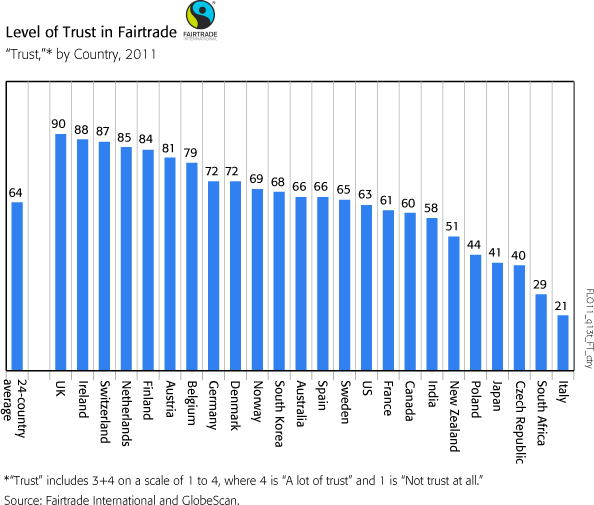
| Figure 1 |
As we see in the first figure well developed Western and Nordic countries trust in Fairtrade more than not as well developed countries from Eastern Europe for example Poland. British trust the Fairtrade more than twice compared to Polish. It could be because of the different mentalities, attitudes, cultural differences or just because the lack of information on what is the Fairtrade, how does it work and why is it good not only for producers but also for us.
UK SUCCESS IN FAIRTRADE MARKET
Probably the best example for small or less developed European countries, how to spread the information about the Fairtrade and its benefits is the United Kingdom. In the UK Fairtrade goods are very actively advertised. Lots of information in newspapers and magazines, children is educated about the benefits of Fairtrade. As well as, there are more than 10,000 local campaigning groups, including Towns, Schools, Universities and Faith Groups, so many ways to get involved in Fairtrade community. Therefore is not a surprise why United Kingdom is a global leader by the consumption of Fairtrade goods. (Figure 2)
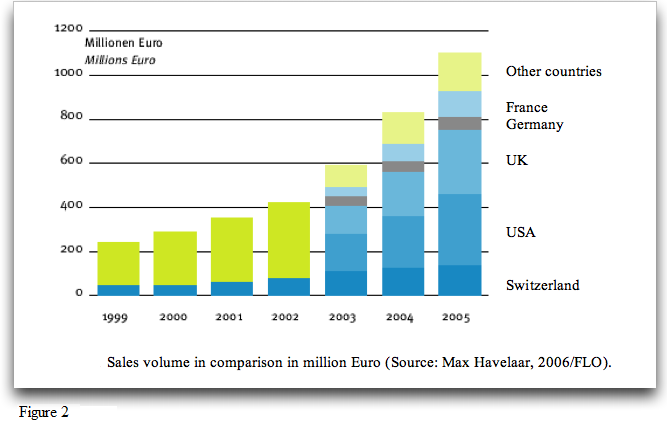
Support for Fairtrade is greater in northern EU Member States than in countries in the south, and greater in the EU15 Member States than in those that have joined the EU since 2004. One of these countries which joined European Union in 2004 is Lithuania and here the demand for Fairtrade is low compared to UK, Sweden or other well developed countries. In Lithuania, talking about the Fairtrade and how it would help for third countries, everything looks very fresh and new.
FAIRTRADE PROBLEMBS IN LITHUANIA
First of all, one of the problems is that Lithuania (as a whole country, including government, media, society) gives only patchy attention for the Fairtrade. There are no systematic scientific studies or articles on this subject even the media does not sufficiently publicize about the Fairtrade movement and its goals. Only in 2008 autumn the first information materials was presented in Lithuanian language and the products began to be marked by special signs.
Although the Fairtrade system involves approximately 1.35 million farmers and workers in 70 developing countries around the world, and the Fairtrade certification mark can be found on more than 30 thousands products, in Lithuania and in other Baltic countries is little known about the Fairtrade, and the choice of its products is modest. Such goods can be purchased but Fairtrade mark is poorly identifiable and it does not promote sales of these products.
In the analysis of “Sąžiningos prekybos plėtros galimybės Lietuvoje” by Alina Kairaitytė and Juozas Ruževičius was made a survey (in the survey participated males and females from 20 to 60 years old). Most of the respondents admitted that they know very little about Fairtrade, or do not know anything. Respondents were familiarized with the idea of the Fairtrade and the characteristics of its products and it turned out that the demand for these goods in Lithuania may exist. Majority of the Fairtrade goods are environmentally friendly, so the demand for these goods is associated with the demand for the organic products. (Figure 3) It was found out, that 97% of respondents who use environmentally friendly products would also purchase Fairtrade goods and 17% of those who do not use environmentally friendly products would always choose Fairtrade goods instead of conventional products, and 73% would also purchase from time to time. Lithuanian customers consent to pay more for Fairtrade products, because these products are healthier, do not have genetically modified organisms and additives. They are also concerned about the social aspects as help and support for the third countries farmers and workers. To sum up, that like one of the main problems in the spread of Fairtrade in Lithuania is lack of information.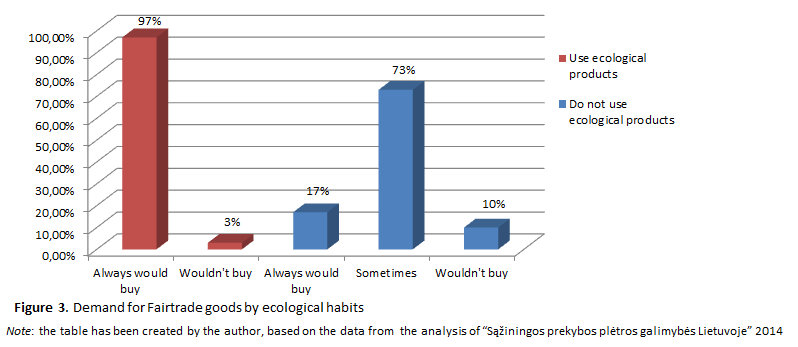
Not all shoppers react in the same way. Usually people think that Fairtrade is associated with middle class or high earners who have more disposable income. We cannot trust evidence for 100%, but it seems like older consumers are more likely to take into account of issues of conscience than younger shoppers. Consumers, who reached higher level of education, are more associated with purchasing Fairtrade products. Also, women seem to have more information about the Fairtrade products and they are willing to purchase more than men. (Figure 4.)
As it was mentioned Fairtrade term or/and mark is relatively rarely seen in the Lithuanian press, in the media or in scientific publications. And although in comparison with other foreign countries, in Lithuania echoes of the Fairtrade products are very slight, but still we are able to find these goods like coffee, tea, sugar, rice, spices and so on, both large supermarkets e.g. (“Maxima”, “IKI”, “Rimi”), and in small business as „One Planet Shop & Lounge“ etc. It is a pleasant surprise for Lithuanian customers, because the world’s perception that people who buy Fairtrade products become part of the democratic movement.
| Note: Table is based on the data from the analysis “Sąžiningos prekybos
plėtros galimybės Lietuvoje“, 2014 |
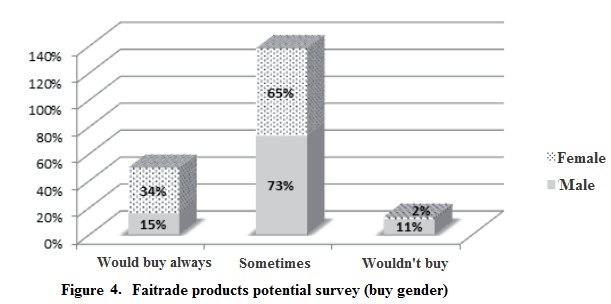
Another problem, why the Fairtrade products are not so popular in Lithuania, is related with managers. Primarily, it is essential to educate marketing managers and top level managers about the outcomes of Fairtrade, its values and benefits, to show the best practices in this field from the foreign countries e.g. UK case, as well as, cultivate their social responsibility. As it was said before, Lithuanians would like not only to buy these products but also they are willing to pay more for them. It is therefore likely that this fact could be one of the additional motifs for the supermarkets managers to expand the Fairtrade products assortment in Lithuanian stores.
SITUATION IS GETTING BETTER
Fairtrade movement in Lithuania step by step is finding its niche. Gradually, our country’s consumers are becoming more aware, and the Fairtrade label is increasingly recognized. However, we should remember that this movement in Lithuania has come relatively recently so the Fairtrade labeled products and sales are growing slowly. It is important to realize that all of us can actually contribute to the welfare of developing countries every time when we choose coffee, cocoa, tea and other products produced by Fairtrade movement members.
As we can see in the Figure 5, 2010 was a great year of spectacular growth for Fairtrade. Consumers spent €4.36 billion on Fairtrade goods, a 27 percent increased on 2009. The sales increased more than tripled in the Czech Republic, Lithuania also showed great results here the sales increased more than 2.3 times, around 138%.
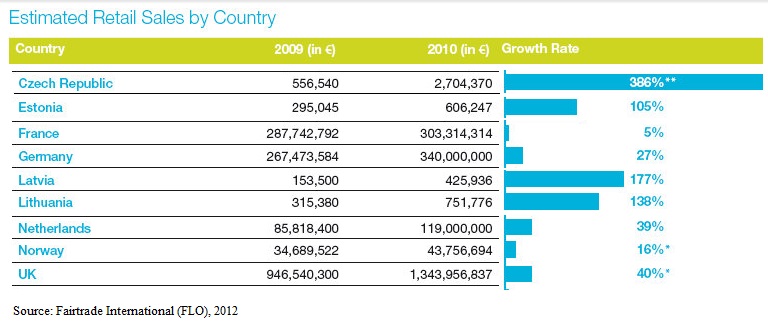
| Figure 5 |
Providing consumers with information about Fairtrade products and their benefits for third countries can be important factor in influencing consumer behavior but only this would not be enough. It is necessary important of long term consciousness-raising and promoting better perception of not only their countries but also national and global political issues.
SPREAD THE BELIEF INTO THE FAIRTRADE
In the end of 2013, Lithuania has launched a new project “Fairtrade: raising awareness”, which was initiated and coordinated by the Lithuanian Consumer Institute. This project took a place at the same time in three Baltic States (Lithuania, Estonia, and Latvia). The purpose of this project was to raise public awareness of the Fairtrade movement, to support actions for fairer relations between developed and developing countries, to increase awareness of the problems and difficulties faced by the developing world and to promote the development of education, as well as, mobilize greater support for actions against poverty in developing countries.
During the project there was provided many activities to different groups (pupils, students, youth organizations leaders, teachers, adults, businesses people):
Publication “Fairtrade Guide”;
Cartoons for the pupils;
An interactive educational game;
Training courses for students;
Ideas workshops;
Fairtrade fair;
Special events in supermarkets and in music festivals;
International conference, etc.
There are some ways how to advertise this trade. For example: to facilitate the delivery of the Fairtrade products to the supermarkets, spread the ideas of Fairtrade, to publicize the results which were achieved in this trade movement, also the positive impact, to the third countries residents and producers, which was achieved with the help of each of us.
EMPIRICAL RESEARCH RESULTS AND VALUATION
This research was made to see the Fairtrade role in the Europe and to analyze the Fairtrade movement situation in Lithuania. Also, the main aim was to understand why this trade’s products are popular in well developed countries as United Kingdom, Sweden, etc. and it faces low demand in such countries as Lithuania.
Western European countries started to sell and to talk about the Fairtrade products few decades earlier compared with Eastern European countries. Therefore, nowadays they do not need any additional information about the Fairtrade, westerners can easily recognize the label of this trade and they know that they can help for poor farmers, who work a lot and at the same time earn nothing. The United Kingdom is the leading country in the Europe by the sales of Faitrade products. This should not shock, because UK was the first country which started to import goods from the third countries, and to pay off not to suppliers but direct to manufacturers. Furthermore, in Great Britain children are taught about the fairtrade, its benefits and support for the people who need this, and also they know, that Fairtrade goods are healthy, ecologically friendly without any GMO. Children have a change to choose Fairtrade schools, students – Fairtrade universities, there is an opportunity to live in Fairtrade Town. Hence, United Kingdom works a lot on promoting the Fairtrade, so that’s why this country has the highest demand on these products.
Totally different situation is in Lithuania, only eight years ago was presented the first material in Lithuanian about the Fairtrade and only then products began to be marked by special signs. It is not easy to find information in daily media, so there are a lot of people who have never heard the term – Fairtrade. Moreover, supermarkets and some small boutiques can offer only small quantity of the Fairtrade products. In this way, people do not have lots of choices, so usually they are willing to stay to their regular basket of goods instead of trying unheard things. On the other hand, the survey showed that the main problem is the lack of information about the Fairtrade products. During the survey Fairtrade aims and goals were represented to the respondents and the majority of them admitted that they would like to buy these goods. Because now they know, that it is easy to contribute to the support for these farmers and help to avoid the poverty, child labor, gender inequality and other iniquities in this world.
Another problem on Fairtrade demand in Lithuania is also related with lack of information. In this case, it is not about the consumers but about the managers, company owners and so on. Whereas usually their shops cannot “boast” of variety of Fairtrade products. This is because some of them still do not understand that it is a great way to increase their profits and do a good job for this planet. However, the beginning of this new brand was hard in Lithuania, but now the situation is getting better. More and more people know this brand and its meaning.
In the end of 2013, in Lithuania began a new project “Fairtrade: raising awareness”. This step might absolutely change the situation and definitely raise the consumption of the Fairtrade products. Whereas, was created a lot of events, promo companies, cartoons for pupils, training courses and other things which could help to spread the information about the “better tomorrow”. To sum up, we can still feel the difference between two sides of Europe, if we talk about the Fairtrade and its acceptance. Western part is leading, but the Eastern part is getting more involved every day, it seems like the small isolation between them will fade soon. Data shows that nowadays many people decide to follow the Fairtrade idea and to “stretch out the helping hand” to the third countries.
CONCLUSIONS
The main purposes of this article is to analyze the model of Fairtrade in Europe and especially in Lithuania, to analyze why there are differences of Fairtrade popularity between European countries. The paper consists of the three main parts: theoretical analysis of the Fairtrade, European and Lithuania’s case, which problems Lithuania face, and research of this topic, as well as, the empirical research results valuation. The paper also includes the analysis of literature, research with its results and a developed model.
The paper had purposes to answer the questions as: what is the situation with Faitrade in Europe, what is the difference between the European countries, why they cannot show similar results on selling Fairtrade labeled products, as well as, examination on United Kingdom success in Fairtrade and the main research was based on Lithuania’s case. Which problems it faces and how to raise the demand level of the Fairtrade products.
After the analysis of this topic I found out that, the Fairtrade is a social movement whose main goal is to assist producers not in the strong countries but in developing countries, to achieve better, higher trading conditions and also to promote sustainability. Also, it is necessary in our life, because it helps for farmers from undeveloped countries to get fair payment for their work, as well as, protects workers’ rights, tries to avoid child labor, gender inequality and climate changes, and helps to access the finance.
The main result of the analysis was that different literature and data showed that Lithuanians are still not fully involved, they feel lack of information and this is the main reason why Lithuanian cannot compete on Fairtrade products sales, between other European developed countries. Lithuanians showed the willingness to purchase these goods, only after when they were educated about the Fairtrade and its benefits.
It was few times mentioned, that the UK is the best example by the demand of Faitrade goods. So, on my own opinion, the best solution for Lithuania is to align with United Kingdom, first of all, to start educate children from the childhood, second it is necessary to have more information about the Fairtrade on media as newspapers, magazines, TV, it is important to show, that just by buying one or another good we can save lots of families. Last but not least, Faitrade should involve more young people, by organizing events, competitions or volunteering programs.
REFERENCES
Articles:
Internet source entries:
Marlike Kocken, SIXTY Years of Fair Trade. A brief history of the Fair Trade movement.
Internet access: <http://www.european-fair-trade-association.org/efta/Doc/History.pdf>, (November 2006)
Alina Kairaitytė, Juozas Ruževičius, Sąžiningos prekybos plėtros galimybės Lietuvoje,
Internet access: < http://vddb.library.lt/fedora/get/LT-eLABa-0001:J.04~2014~ISSN_2335-750.N_69.PG_71-88/DS.002.0.01.ARTIC>, (March 03, 2014)
GlobeScan, Shopping Choices Can Make a Positive Difference to Farmers and Workers in Developing Countries: Global Poll
Internet access:< http://www.globescan.com/news-and-analysis/press-releases/pressreleases-2011/94-press-releases-2011/145-high-trust-and-global-recognition-makes-fairtrade-an-enabler-of-ethical-consumer-choice.html>, (11 October 2011)
Kathryn Wheeler ‘CHANGE TODAY, CHOOSE FAIRTRADE’ Fairtrade Fortnight and the citizen-consumerInternet access: <http://oro.open.ac.uk/38741/9/Change%20Today%252C%20Choose%20Fairtrade%20revised2.pdf>, (July 2012)
Environews Spheres of Influence, Certified Coffee. Does the Premium Pay Off? (September 2007)
From a journal:
Unknown (2007). Certified Coffee. Does the Premium Pay Off? // Environews Spheres of Influence, Fall.
Others:
http://www.european-fair-trade-association.org/efta/index.php
http://www.fairtrade.net/about-fairtrade/history-of-fairtrade.html
http://www.fairtrade.org.uk/en